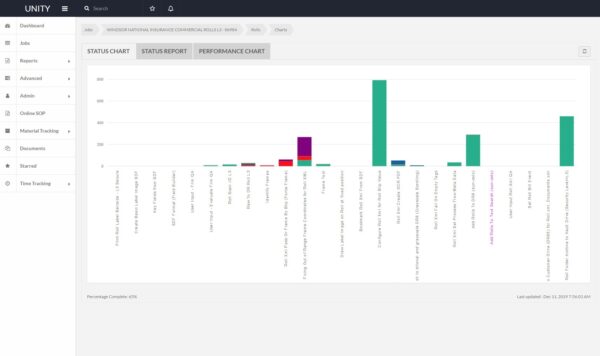Not everyone has a paper scanning project with hundreds of boxes or millions of pages. Sometimes it’s a small office that needs a few files scanned, or a department with a batch of records they want to digitize to get caught up.
Although we focus on large-scale scanning projects, we work on smaller paper scanning jobs quite often. The overall objective is the same: successfully scan and convert hard copy records to digital. But because of the smaller scale of the project, we adjust our typical workflow to accommodate these types of projects to create a simpler project and shorter timeline.
Read below to see the steps to get your small paper scanning project completed with us.
1 – Receive Paper
First things first, we need to have your records on hand to be able to scan them.
Since we’re talking about a small project, how you get them to us depends on location. If you’re close to our offices, we could pick them up for you. You might also drop them off yourself.
If you’re far away (such as in another state) you’ll likely ship them to us on a pallet.
In most cases, if you’re not close to one of our offices there’s a small chance you’ll work with us anyway; most clients keep their paper scanning local because of transportation costs.
Once we get your records, we’ll tag the containers they came in (likely bankers boxes or something similar) with a barcode sticker. This tag will contain information related to your project, such as the project number, your company’s name, date received, and other related data. This barcode is used throughout the project so we know where your documents are in the process, how many images have been scanned, and who’s handling the records.
The platform we use to track this info is called the Material Tracking System (MTS) and was built by our own software team to handle the specific abilities our project folks needed. At any time during your project, we’ll be able to tell you where a certain record is and what’s going on with it.
2 – Create Process Flow
Next step in your project is creating the process flow. The process flow is the step-by-step method by which we’ll scan and convert your records.
Even though it’s a small project, we utilize a process flow to track the records throughout the job and make sure that it’s done properly. Granted, the process flow is going to be simpler than what we may do with a larger and more complex project, but a process flow will be used anyway.

3 – Prep Records For Scanning
As with all paper scanning projects, the preparation (or “prep”) is a crucial part in the process.
Prepping your records ensures that the pages will cleanly and smoothly move through our scanners and capture properly. If prep is done incorrectly, a wayward staple or paperclip could jam the scanner, or a tear in a page could become a completely shredded record.
Prep is one of the most essential parts of any paper scanning project.
To see prep in action, check out our video here.
4 – Scan Records
Scanning your records is the whole reason you’re doing this project!
Once the files are prepped, they’re scanned and digitized. We have various types of scanners that are used based on the condition of the material you send us, the specs/requirements of your project, and also the size of the pages.
During scanning, our people are visually checking to ensure that each page is properly captured and that there are no issues with the digitized image. After scanning, the pages are “back prepped” and replaced in the boxes they came from.
5 – Post-Scan Image Processing
A post-scan image processing step is conducted after your records are scanned. The sub-steps in this phase may or may not be required, depending on your project specs.
Quality assurance (QA) checks are part of the post-scan image processing phase. We review the scans to ensure that we’ve accurately captured the images and are providing you with a quality result. As mentioned in the scanning phase, our people are checking as the pages are scanned but for certain projects we have a post-scan QA step, as well.
Optical character recognition (OCR) can be applied to your images to make them text searchable. It’s not a guarantee that every word and phrase will be searchable, but normally does a pretty good job of helping you find data on your files.
If you have documents that contain sensitive data, you might ask for redaction services to remove certain pieces of information. Typically, items such as Social Security Numbers, Dates of Birth, and Medical Record Numbers are redacted.
The last step in the post-scan process is indexing. We’ll organize and name your files based on the scope of work. For small paper scanning projects, we typically index from the folder or binder, assuming the records in each box are organized that way. Our Digital Box method is also a simple and cost-effective way to index.
6 – Project Delivery & Material Return
The last step in the project is to return your digital documents and hard copy records.
Once all the other steps are complete, we’ll export your digital images and data to a USB (likely a thumb drive since it’s a small project) and send the USB and your original hard copy files back to you. Disposal is also an option if you’re looking to destroy the hard copies once they’re scanned.
If your records contain sensitive data (such as HR files, student records, HIPAA data) then we’ll encrypt the USB so it’s better protected.
Timeline
Small paper scanning projects are generally under 100,000 pages (roughly 40 boxes), so once we receive all the records the whole project will take about 3-5 weeks.
If you have a different timeline we can adjust the schedule, but 3-5 weeks is a good estimate to start from.
Next Steps
Reach out to us today! Click the “Get Your Quote” button below, fill out the form, and we’ll quickly reply to you to discuss your project.
Further Reading
“How Much Will You Pay For A Small Paper Scanning Project?” Find out the costs of a small paper scanning project along with the deliverable you’ll receive, the process to get it done, and other options you have available to you.
“How To Prepare For Your Paper Scanning Project” Getting ready to start a paper scanning project? Here are four ideas to help you prepare and be ready to make your project a success.
“Digital Box Scanning” When you’re figuring out which way you want to scan your paper records to an electronic format, consider the Digital Box method. You get a simple and effective way to digitize your files.

